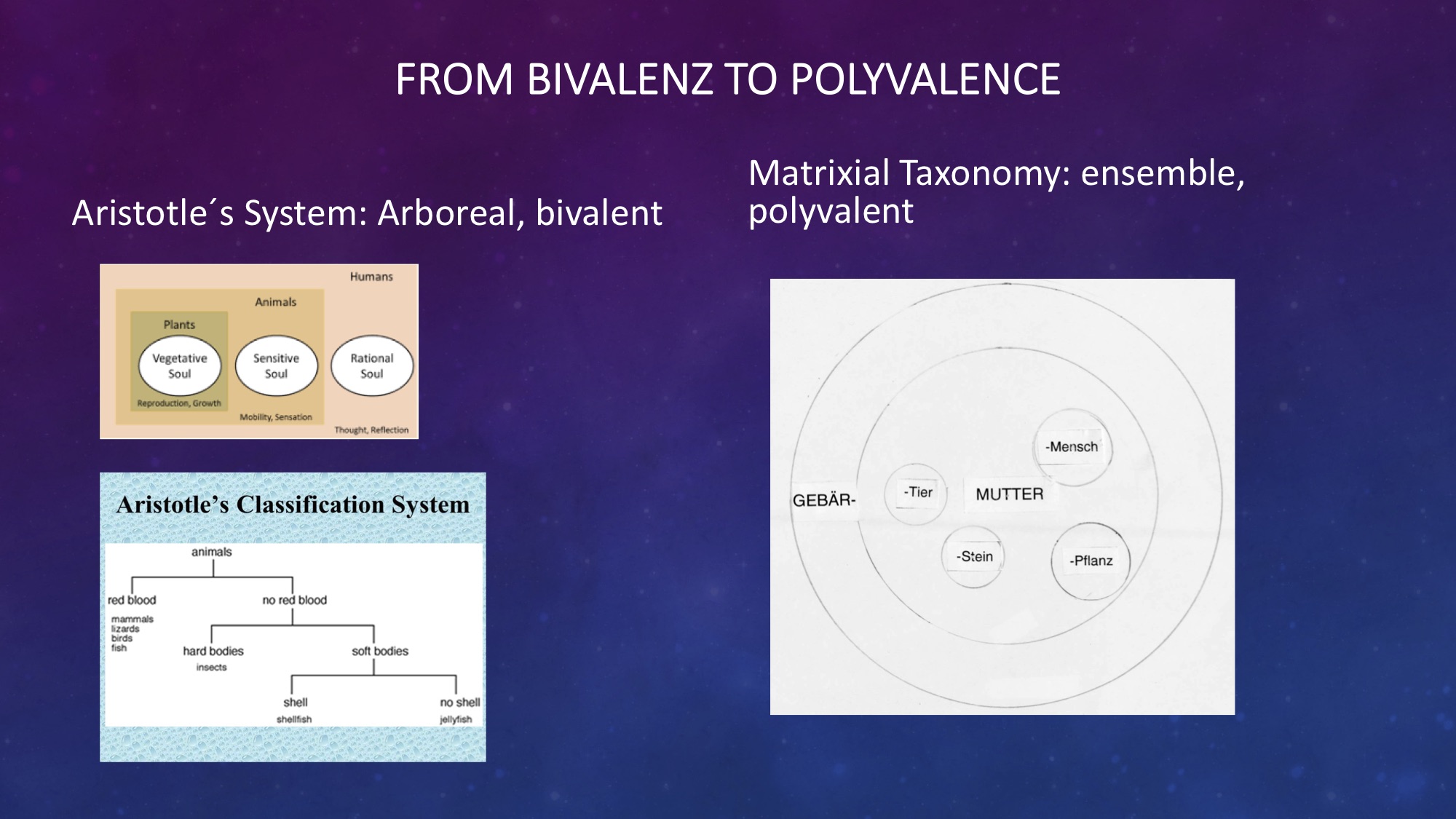
A SYSTEMATIC ATTEMPT TO THINK GENDER IN PHYLOGENETIC TERMS
Keywords: mother animal, mother human, collective epistemology, species, genus, eidos.
- Gender placement. Gender: ‘Late Middle English: from Old French gendre (modern genre), based on Latin genus ‘birth, family, nation’. The earliest meanings were ‘kind, sort, genus’ and type or class of noun, etc.’ (which was also a sense of Latin genus).’
‚The totality of characteristics that define a living being as male or female, family, generation, species, genus‘, ahd. gislahti n. (um 1000), mhd. gesleht(e) n. ‚Sex, tribe, descent, family, species‘, mnd. geslechte, mnl. gheslachte, gheslechte, nl. geslacht steht als Kollektivum neben gleichbed. ahd. slaht n., slahta f., slehti n., mhd. slaht(e) f., slehte n.[1]
The purpose of this essay is to give weight to the category of gender and its rich polysemic diversity. It aims to deconstruct the gender discourse in regards to the classification of species, in order to grasp the original meaning of the term ‘genus’. The wide polysemic variety points to a “composition of individuals that remains preserved over time”. Whether individual organisms are subdivided into species and genera according to their reproduction, or the individuals are grouped into families according to blood inheritance, and whether the organically structured matter is assigned to a group due to its morphological appearance, is a question of the order of genera and gender. - Gender: an epistemology for relations. Lineage and gender share the same meaning, that of “belonging to a group”. In this sense, gender offers an excellent opportunity to draw upon an epistemology of relations. On the one hand, it points to the combination of individuals and organisms, and on the other to their cohesion. It is grouped according to species and genus; the association of individuals expresses a direct belonging to the association of each species – animals, humans, plants, etc.
- From the point of view of an epistemology of gender, the questioning of bivalent sexual difference leads to the generalization of two values. Assuming that gender is a category of connections and relations, this raises the question of why the difference between two values is generalized to a category of genus, instead of looking for the reason why sexual difference is reflected in two values. The question is not why sexual difference occurs in two values, but rather why gender, namely genus, is generalized in two values. Why should difference be considered a category of generalization? A critical approach to the category of gender requires a deconstruction of the logical structure between species and genera.
- Order of living beings. Individual organisms are classified into species and genera. They are allocated to a taxonomy. Just as discerned reality is integrated into an order of laws and rules, the groupings of individuals are also classified into a system of divisions and collations according to laws and regulations. The challenge of an epistemology of gender lies in treating the order of genera critically and revealing the logical core on which it is based.
- The order of species and genera is logical and metaphysically constructed. Subdivision into species and genera goes back to the method of classification and assignment of terms. The classical logic of Plato and Aristotle defined genus (genos) as the highest universal predicate and the species (eidos) as their specific difference. This logical structure allows only two values, which produces an arboreal taxonomy: arboreal systems are hierarchical and contain centres of significance.
- The question is not why sexual difference occurs in two values, but rather why gender, namely genus, is generalized in two values. Why should difference be considered a category of generalization? A critical approach to the category of gender requires a deconstruction of the logical structure between species and genera.
- Intro-References inwards and Intro- observation inwards. Based on a critical position on the bivalent logical structure of gender difference, this article focuses on clarifying the arrangement of genera and species from the perspective of interior connections of species. It does not deal with the question of what distinguishes animal from human, and female from male. Rather, attention is drawn here to the endo-relationships (interior relationships) between species. This operation is not achieved through a simple search for similarities but instead by using a process of observing interior order and the mutual relationships of living beings with one another: how much animal is there in humans? How much plant is there in animals? An endo-observation (look inwards) of the phylum of living beings is intended to reverse the hierarchically systemized classification of species and genera and to present a different picture than that of an arboreal system.
- Mother X: the thread of interiority. This article puts forward the thesis that the mother figure revokes the logical bivalent taxonomy eidos/genus. Through the figure of the mother, systematic division into species and genera becomes contradictory. Firstly, in the sense that the figure of the mother already relies on is based or constitutes the collective; secondly, in the sense that the maternal lineage overrides the interrelationships of animal/human/plant/mineral, etc. The history of their descent is not linear, but rather hybrid and correlational. The significant and the figure of the mother serve as a structure of endo-relationships.
[1] Etymology of the word ‘gender’, Oxford University Press
(https://www.lexico.com/en/definition/gender, accessed 23.03.2020).
